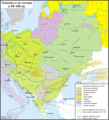Fasciculus:Slav-7-8-obrez.png

Mensura huius perspectionis: 544 × 599 elementa imaginalia. Aliae mensurae: 218 × 240 elementa imaginalia | 436 × 480 elementa imaginalia | 698 × 768 elementa imaginalia | 930 × 1 024 elementa imaginalia | 1 860 × 2 048 elementa imaginalia | 3 051 × 3 359 elementa imaginalia.
Sua resolutio (3 051 × 3 359 elementa imaginalia, magnitudo fasciculi: 339 chiliocteti, typus MIME: image/png)
Historia fasciculi
Presso die vel tempore fasciculum videbis, sicut tunc temporis apparuit.
| Dies/Tempus | Minutio | Dimensiones | Usor | Sententia | |
|---|---|---|---|---|---|
| recentissima | 15:13, 12 Augusti 2023 |  | 3 051 × 3 359 (339 chiliocteti) | Gyalu22 | Reverted to version as of 13:16, 23 October 2022 (UTC) Look at the atlas, don't do your own research |
| 17:43, 1 Iunii 2023 |  | 3 051 × 3 359 (309 chiliocteti) | Shibbolet3579 | enice was still in the Byzantine Empire at this time. Avars were also present around Vienna and in central Transylvania, evidenced by graves & toponyms. There was a linguistic contact between Albanians and Vlachs, evidenced by the non-Slavic words present in both languages. Placed the Etelköz of the Magyars and the Crimean byzantine Greeks. South-Slavic toponyms (as Trnava for "tip, hillock, mound") evidenced a South-Slavic presence in southern Transylvania. Concerning the Eastern romance spe... | |
| 13:16, 23 Octobris 2022 |  | 3 051 × 3 359 (339 chiliocteti) | Gyalu22 | Reverted bad faith edit, restored to version as of 26 July 2011. The Westermanns Atlas is an irrelevant source for the previous map, as only the Southern Carpathians are shown as possibly inhabited by the Wallachians. | |
| 15:09, 28 Aprilis 2014 |  | 3 051 × 3 359 (302 chiliocteti) | Spiridon Ion Cepleanu | Bulgarian kingdom & east-romance vlachs according with the universitary atlases of history and the Grosser Atlas zur Weltgeschichte, dir. Hans-Erich Stier, Westermann, 1985, ISBN 3-14-10-0919-8, pp. 50, 55-57, 61 & 64. | |
| 18:27, 26 Iulii 2011 |  | 3 051 × 3 359 (339 chiliocteti) | Koryakov Yuri | The map's resolution is drastically decreased. Undo | |
| 04:53, 26 Iulii 2011 |  | 544 × 599 (329 chiliocteti) | Spiridon Ion Cepleanu | On the original version of this map, the eastern romance language-spoken populations ("Vlachs" or "Volokhs") are draw only in a little area around Sredets (today Sofia), according with only one of the POVs, called "Röslerian" (since Eduard Robert Rösler | |
| 13:52, 10 Martii 2008 |  | 3 051 × 3 359 (339 chiliocteti) | Koryakov Yuri | {{Information |Description= |Source= self-made |Date=March 2008 |Author= Koryakov Yuri |other_versions= }} == Licensing == {{self|cc-by-sa-3.0}} Category:Maps of the history of Russia in Russian [[Category:Maps |
Nexus ad fasciculum
Ad hunc fasciculum nectit:
Usus fasciculi per inceptus Vicimediorum
Quae incepta Vici fasciculo utuntur:
- Usus in ar.wikipedia.org
- Usus in arz.wikipedia.org
- Usus in azb.wikipedia.org
- Usus in ba.wikipedia.org
- Usus in be-tarask.wikipedia.org
- Usus in be.wikipedia.org
- Usus in bg.wikipedia.org
- Usus in ce.wikipedia.org
- Usus in cs.wikipedia.org
- Usus in cv.wikipedia.org
- Usus in da.wikipedia.org
- Usus in de.wikipedia.org
- Usus in en.wikipedia.org
View more global usage of this file.

